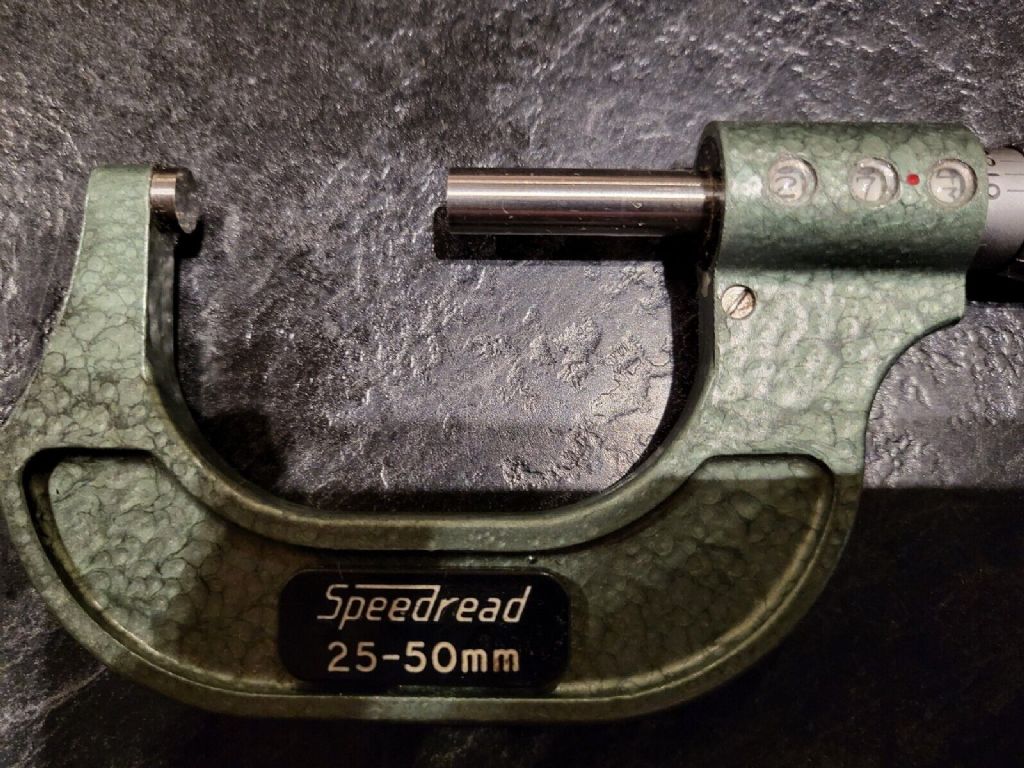GKN 'Speedread' micrometer
| Siddley | 22/11/2012 18:29:17 |
150 forum posts 1 photos | Does anyone know anything about these mechanical\digital mikes ? I've got an imperial 0-1" version and I'd love to find it a metric friend. It's no more or less accurate than any of my other mikes, but I just think the mechanism is very cool ( and easy to read of course ) |
| peak4 | 22/08/2023 16:09:33 |
2207 forum posts 210 photos | To rejuvenate a very old thread, does anyone have a manual, or a knowledge of how to re-set/calibrate these mics please.
Bill |
| peak4 | 23/08/2023 19:08:06 |
2207 forum posts 210 photos | For completeness in case anyone searches for this in the future. A Few Notes on Re-indexing a GKN-Shardlow 25-50mm Speedread Micrometer. N.B. is isn’t an official procedure, and very much trial an error, with lots of the latter. Please read in conjunction with the US patent for a micrometer from 1956 by Davenport. A recent purchase of a good used example of this micrometer arrived with the direct reading numeric display out of sync with both the spindle and adjacent digits. Disassembly (partial) First I needed to partially disassemble the instrument, but fortunately I didn’t need to dismantle the gearbox or display itself. The thimble is held on a taper at the end of the main spindle No.14 but just removing the end screw only releases the knurled adjusting collar. I’ve no idea how you are supposed to release the thimble from the taper without a special tool, but this worked for me; unscrew the thimble as far as it will go and wind it back in very slightly to avoid straining anything. Re-assembly to follow in the next post |
| peak4 | 23/08/2023 19:09:54 |
2207 forum posts 210 photos | Reassembly Much trial and error here, in order to get the indexing correct for workpiece length. I selected a 35mm gauge block and slid the main spindle down the bore to contact it (I didn’t have one, so used a 25mm block on end; it doesn’t need to be exact, but should be close to a known measurement to allow for the differential screw compensation). Slide on the thimble, don’t forget the ratchet spring, with the micrometer still measuring a block, and replace the end screw, align a suitable mark, gently nip up the taper, only lightly finger tight. Edited By peak4 on 23/08/2023 19:28:33 |
| Rolster | 24/08/2023 12:13:26 |
| 19 forum posts | Bill many thanks for the detailed explanation and link to the drawing. I have an one inch imperial version back at home which has a very stiff spindle and needs to be overhauled, but without the drawing it looked a bit dicey, so now forearmed with your research and drawing, i'll give it a go. I am not sure how the spindle got so stiff but as it was second hand when i bought it in the last century and came in a belt pouch so probably was sat on at some stage. BR Roland |
| peak4 | 24/08/2023 12:30:57 |
2207 forum posts 210 photos | Posted by Rolster on 24/08/2023 12:13:26:
Bill many thanks for the detailed explanation and link to the drawing. BR Roland Bear in mind that the drawing relates to the original patent from 1916 (not 1956 as per my typo) and the production models of the GKN-Shardlow do differ. Edited By peak4 on 24/08/2023 12:44:22 |
Please login to post a reply.
Want the latest issue of Model Engineer or Model Engineers' Workshop? Use our magazine locator links to find your nearest stockist!
Sign up to our newsletter and get a free digital issue.
You can unsubscribe at anytime. View our privacy policy at www.mortons.co.uk/privacy
- hemingway ball turner
04/07/2025 14:40:26 - *Oct 2023: FORUM MIGRATION TIMELINE*
05/10/2023 07:57:11 - Making ER11 collet chuck
05/10/2023 07:56:24 - What did you do today? 2023
05/10/2023 07:25:01 - Orrery
05/10/2023 06:00:41 - Wera hand-tools
05/10/2023 05:47:07 - New member
05/10/2023 04:40:11 - Problems with external pot on at1 vfd
05/10/2023 00:06:32 - Drain plug
04/10/2023 23:36:17 - digi phase converter for 10 machines.....
04/10/2023 23:13:48 - More Latest Posts...
- View All Topics
- Reeves** - Rebuilt Royal Scot by Martin Evans
by John Broughton
£300.00 - BRITANNIA 5" GAUGE James Perrier
by Jon Seabright 1
£2,500.00 - Drill Grinder - for restoration
by Nigel Graham 2
£0.00 - WARCO WM18 MILLING MACHINE
by Alex Chudley
£1,200.00 - MYFORD SUPER 7 LATHE
by Alex Chudley
£2,000.00 - More "For Sale" Ads...
- D1-3 backplate
by Michael Horley
Price Not Specified - fixed steady for a Colchester bantam mark1 800
by George Jervis
Price Not Specified - lbsc pansy
by JACK SIDEBOTHAM
Price Not Specified - Pratt Burnerd multifit chuck key.
by Tim Riome
Price Not Specified - BANDSAW BLADE WELDER
by HUGH
Price Not Specified - More "Wanted" Ads...
Do you want to contact the Model Engineer and Model Engineers' Workshop team?
You can contact us by phone, mail or email about the magazines including becoming a contributor, submitting reader's letters or making queries about articles. You can also get in touch about this website, advertising or other general issues.
Click THIS LINK for full contact details.
For subscription issues please see THIS LINK.
Model Engineer Magazine
- Percival Marshall
- M.E. History
- LittleLEC
- M.E. Clock
ME Workshop
- An Adcock
- & Shipley
- Horizontal
- Mill
Subscribe Now
- Great savings
- Delivered to your door
Pre-order your copy!
- Delivered to your doorstep!
- Free UK delivery!











 Register
Register Log-in
Log-in


